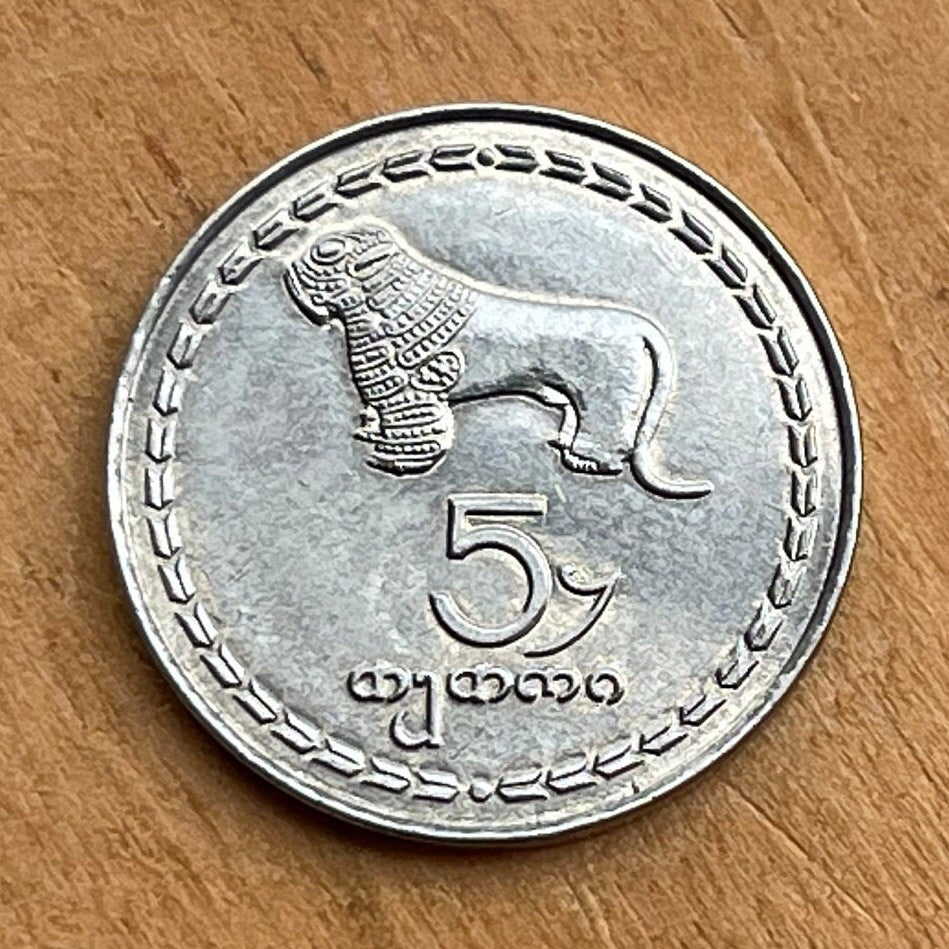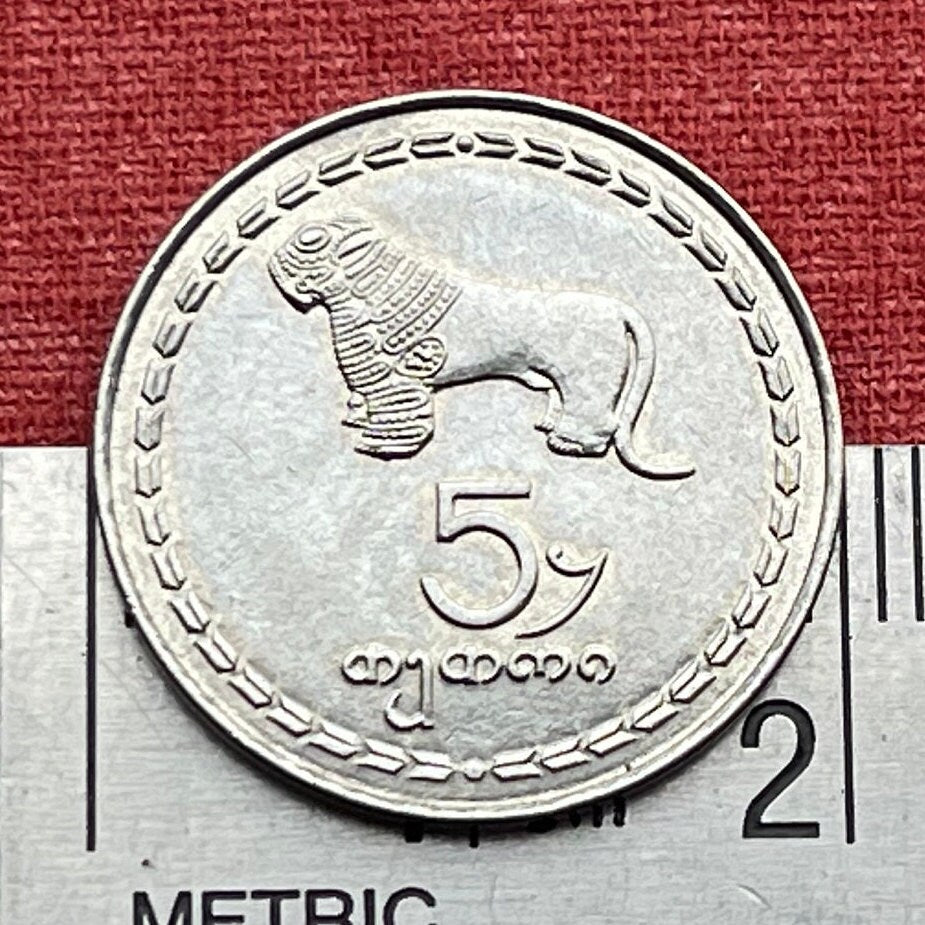elemintalshop
Ancient Tsnori Lion & Borjgali 5 Tetri Georgia Authentic Coin Money for Jewelry and Craft Making (Golden Lion) (1993) (Kurgan)
Ancient Tsnori Lion & Borjgali 5 Tetri Georgia Authentic Coin Money for Jewelry and Craft Making (Golden Lion) (1993) (Kurgan)
Couldn't load pickup availability
Ancient Tsnori Lion & Borjgali 5 Tetri Georgia Authentic Coin Money for Jewelry and Craft Making (Golden Lion) (1993) (Kurgan)
Reverse: Famous archaeological discovery: a Golden Statuette of a lion, from the 23rd century B.C. -- Found in a kurgan burial mound, in Alazani Valley, Georgia. (Found near the village of Tsnori, in the district of Kakheti).
Lettering: 5 თეთრი
Translation: 5 Tetri
Obverse: Borjgali, a Georgian symbol of the Sun with seven rotating wings, over the Christian Tree of Life, with the country name in Georgian above and in Latin below
Lettering: საქართველოს რესპუბლიკა
REPUBLIC OF GEORGIA
1993
Translation: Republic of Georgia
Republic of Georgia
1993
Features
Issuer Georgia
Period Republic (1991-date)
Type Standard circulation coin
Year 1993
Value 5 Tetri
0.05 GEL = USD 0.017
Currency Lari (1995-date)
Composition Stainless steel
Weight 2.5 g
Diameter 20 mm
Thickness 1.32 mm
Shape Round
Technique Milled
Orientation Coin alignment ↑↓
Number N# 3769
References KM# 78, Schön# 9
Tsnori Lion – golden artifact, created in the second part of the III millennium BC, the symbol of power, royal authority, superiority, nobility, pride, sun… Tsnori Lion – the first sculptural representation in South Caucasus, the most important brand of contemporaneity. It was discovered in 1977 in Alazani Valley, in burial grounds, by the Doctor of Science of History, the member of the National Academy of Science of Georgia, the leader of the archaeological expedition of Kakheti, - Konstantie (Kiazo) Pitskhelauri, which is now the guest of “Online Archeology” and will tell our reader about his work:
Q: Tell us about the Tsnori Lion and please describe the artifact.
A: In 1977, the Kakheti expedition was working under my leadership. In the beginning, we discovered a luxurious barrow. The deceased was placed on the cart. The extraordinary inventory, which was found there, indicated that the burial ground belonged to the chief or noble person. After the excavations were finished and the material was put away, my colleague and I were inspecting the excavated burial ground in the evening, at the sunset. Suddenly, something bright appeared in the ground and I got interested. I saw a small golden sculpture, - it was the Tsnori Lion. It is possible that the artifact was the decoration of the cart. We established that, such kind of a lion should have been placed on all four wheels of the cart. Unfortunately, only one was found out of four. As a result of analysis, the artifact itself was dated 23rd century BC. It was the clay, covered with gold. It is the unusual example of goldsmith, created with the use of highest technology, - even with the use of modern apparatuses, it is impossible to create a filigree sculpture of such kind. Inside, there is cavity; traits of the lion are realistic, which indicates that artifact is a local piece of work. By the way, it follows from the scientific value of the lion, that the Tsnori Lion was recognized to be one of the biggest archaeological discovery.
Source: https://www.heritagesites.ge/uploads/files/59f3510335a4a.pdf
*****
Wikipedia:
Borjgali (Georgian: ბორჯღალი; also Borjgala or Borjgalo) is a Georgian symbol of the Sun with seven rotating wings around a tree of life. The borjgali can be considered as a main symbol of Georgian culture.
Etymology
The term Borjgali is believed to derive from Megrelian word ბარჩხალი (barchkhali), which literally means "strong shining". Some other scholars believe that it has different origins. In old Megrelian borj means "time" and gal means "pass" or "flow". So the whole phrase would mean "the flow of time".
Usage
This pre-Christian symbol was widely used in both western (Colchis) and eastern Georgia (in Georgian architecture's Dedabodzi (pillar) as part of the Kura–Araxes culture) as a holy symbol. During the medieval period, this symbol was incorporated as a part of Christian symbolism Nowadays, the symbol is used in Georgian IDs and passports, as well as on currency and by the Georgian Rugby Union. Georgian rugby team players are called ბორჯღალოსნები (borjgalosnebi), which means "Men bearing Borjgali". It was also used on the naval ensign of Georgia during the late 1990s and early 2000s. Georgian nationalists often use symbol to emphasize national pride.
******
WIkipedia:
The tree of life is a fundamental widespread mytheme or archetype in many of the world's mythologies, religious and philosophical traditions. It is closely related to the concept of the sacred tree.
The tree of knowledge, connecting to heaven and the underworld, and the tree of life, connecting all forms of creation, are both forms of the world tree or cosmic tree, and are portrayed in various religions and philosophies as the same tree.
Share










5 stars review from Paige
5 stars review from Crystal









